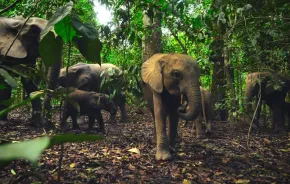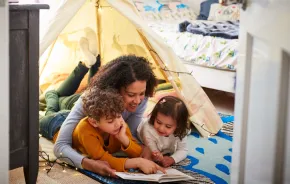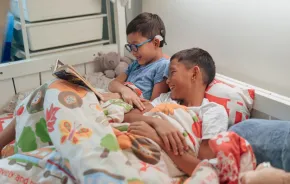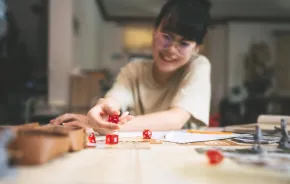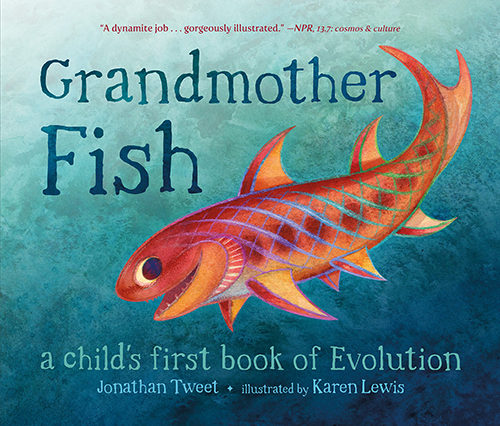
When Jonathan Tweet’s daughter was in preschool, he wanted to teach her about evolution. But the Seattle dad couldn’t find a single kid’s book on the topic — so he wrote one himself. It took 15 years (that preschooler is now in her 20s) but Tweet is thrilled a book that started out as “just a pipe dream” is now being read aloud to preschoolers across the country.
The book, Grandmother Fish, published in September 2016, and has received rave reviews from outlets including NPR and the School Library Journal.
Tweet, who’s a game designer by trade, never imagined such a warm reception. After all, 34 percent of Americans don’t even believe in evolution. Would young children be interested? But, as Tweet puts it, he wanted to die someday knowing he’d published a book that was deeply important to him.
Originally, Tweet planned to self-publish the book but then he began telling people about it. They wanted to help. That’s how, in 2014, Tweet launched a Kickstarter campaign to raise funds for the book that he’d been working on for years. He reached his funding goal of $12,000 in just two days. A bonus: Kickstarter connected Tweet with Karen Lewis, a Seattle-based illustrator who was eager to collaborate.
The resulting picture book covers the history of life on Earth with a message of connection and community. Tweet and Lewis used an interactive “call and response” text, which prompts kids to mimic sounds and motions (wiggle like a fish or hoot like an ape, for example). The book also includes a back section that features an elaborate illustration of the evolutionary tree of life, science notes for parents and suggestions for how to explain natural selection to a child.
To learn more about Grandmother Fish, I spoke with Tweet about the project and what he hopes families get from it.
Why do you think the topic of evolution hasn't been as explored by picture book authors?
When I first started telling people what I was going to do, many of them were skeptical about the idea of a book on evolution for preschoolers. They responded with surprise and I thought, ‘Why is that surprising? Shouldn’t preschoolers know about evolution?’
It is very difficult to get the story across to little kids … and it’s also really difficult to get it right, so I spent a great deal of time speaking with educators, experts and peers in order to ensure Grandmother Fish did justice to the topic.
Why do you think it’s important to introduce young children to evolution?
Kids love the concept. They love animals and they love families, and evolution is about how we are all part of the animal family. I always knew that adults and parents were going to like the book, but until it was finished, there was really no way to know how children were going to react to it. It turns out they totally love it. A lot of people tell me it’s their kids’ favorite book. They have to read it every night, and some parents jokingly complain because they have to read the book so much.
[The astrophysicist] Neil deGrasse Tyson talks about evolution as a spiritual experience to affirm your connection to all life on earth. For kids, they really respond to the animals in the book. My illustrator, Karen Lewis, helped me develop the family aspect and I think that’s another really important reason kids love it. During the writing process, I spoke with two separate educators who independently told me the no. 1 lesson from evolution that we should take away is that we are all related.
I hadn’t initially thought of that as my message, but I ran with it. Everyone on earth is a family. If we’re a family with possums, clearly we’re a family with all other humans and that’s such an important message, especially in our current political climate.
How did you get the idea for the call and response text?
The call and response text makes the book in a lot of ways — but I didn’t come up with the idea until 2013. I knew something about the book was just not yet quite right. Within one month of leaving my last corporate job at Amazon, I was relaxing in the hot tub and the idea just came to me.
I knew that getting kids to mimic motions and sounds was the ultimate wake-up. It makes the book accessible to even younger children and that’s been sort of miraculous. Talking and mimicking is a first language for kids. It’s the first way that you communicate with children. I came up with it thinking of the origins of language, and how early language was probably mimicking. Kids are developing their language skills and they use mimicry, so it makes the book that much more appealing and accessible to them.
Did your background in game design influence the book at all?
I think so. I learned that you have to coax players to get into the spirit of the game. If you don’t, it’s no fun. So I spent a lot of time figuring out how to write complicated rules where [players] use their imaginations to be part of the game, and that went into my creative process when I was writing Grandmother Fish.
Another thing is, I’ve taught Sunday school for several years at my Unitarian church and I learned that kids react really well to acting things out. They enjoy the spontaneity and it makes learning more memorable and fun.
Have you gotten any pushback from readers?
We have Grandmother Fish accounts on social media platforms like Twitter and Facebook, so we’re really public. We do get feedback from creationists who tell us we’re all wrong, and bloggers have panned the book because of its theme. We get a lot of pushback. Although it’s not clear, there probably are bookstores that aren’t carrying the book because it teaches kids about evolution and that’s a hot-button topic. But, I don’t think the publishers have had any real grief over it.








